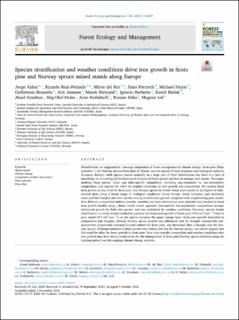| dc.contributor.author | Aldea, Jorge | |
| dc.contributor.author | Ruiz-Peinado, Ricardo | |
| dc.contributor.author | del Río, Miren | |
| dc.contributor.author | Pretzsch, Hans | |
| dc.contributor.author | Heym, Michael | |
| dc.contributor.author | Brazaitis, Gediminas | |
| dc.contributor.author | Jansons, Aris | |
| dc.contributor.author | Metslaid, Marek | |
| dc.contributor.author | Barbeito, Ignacio | |
| dc.contributor.author | Bielak, Kamil | |
| dc.contributor.author | Granhus, Aksel | |
| dc.contributor.author | Holm, Stig-Olof | |
| dc.contributor.author | Nothdurft, Arne | |
| dc.contributor.author | Sitko, Roman | |
| dc.contributor.author | Löf, Magnus | |
| dc.date.accessioned | 2021-10-14T11:19:26Z | |
| dc.date.available | 2021-10-14T11:19:26Z | |
| dc.date.created | 2021-01-25T16:07:25Z | |
| dc.date.issued | 2020-11-01 | |
| dc.identifier.citation | Forest Ecology and Management. 2021, 481 . | en_US |
| dc.identifier.issn | 0378-1127 | |
| dc.identifier.uri | https://hdl.handle.net/11250/2822990 | |
| dc.description.abstract | Mixed forests are suggested as a strategic adaptation of forest management to climate change. Scots pine (Pinus sylvestris L.) and Norway spruce (Picea abies (L.) Karst.) are tree species of high economic and ecological value for European forestry. Both species coexist naturally in a large part of their distributions but there is a lack of knowledge on the ecological functioning of mixtures of these species and how to manage such stands. This paper analyses these species' intra-and inter-specific competition, including size-symmetric vs. size-asymmetric competition, and explore the effect of weather conditions on tree growth and competition. We studied basal area growth at tree level for Scots pine and Norway spruce in mixed versus pure stands in 22 triplets of fully-stocked plots along a broad range of ecological conditions across Europe. Stand inventory and increment cores provided insights into how species mixing modifies tree growth compared with neighbouring pure stands. Five different competition indices, weather variables and their interactions were included and checked in basal area growth models using a linear mixed model approach. Interspecific size-asymmetric competition strongly influenced growth for both tree species, and was modulated by weather conditions. However, species height stratification in mixed stands resulted in a greater tree basal area growth of Scots pine (10.5 cm 2 year − 1) than in pure stands (9.3 cm 2 year − 1), as this species occupies the upper canopy layer. Scots pine growth depended on temperature and drought, whereas Norway spruce growth was influenced only by drought. Interspecific site-asymmetric competition increased in cold winters for Scots pine, and decreased after a drought year for Nor-way spruce. Although mixtures of these species may reduce tree size for Norway spruce, our results suggest that this could be offset by faster growth in Scots pine. How inter-specific competition and weather conditions alter tree growth may have strong implications for the management of Scots pine-Norway spruce mixtures along the rotation period into the ongoing climate change scenario. | en_US |
| dc.language.iso | eng | en_US |
| dc.publisher | Elsevier B. V. | en_US |
| dc.rights | Navngivelse 4.0 Internasjonal | * |
| dc.rights.uri | http://creativecommons.org/licenses/by/4.0/deed.no | * |
| dc.title | Species stratification and weather conditions drive tree growth in Scots pine and Norway spruce mixed stands along Europe | en_US |
| dc.type | Peer reviewed | en_US |
| dc.type | Journal article | en_US |
| dc.description.version | publishedVersion | en_US |
| dc.rights.holder | © 2020 The Authors | en_US |
| dc.source.pagenumber | 12 | en_US |
| dc.source.volume | 481 | en_US |
| dc.source.journal | Forest Ecology and Management | en_US |
| dc.identifier.doi | 10.1016/j.foreco.2020.118697 | |
| dc.identifier.cristin | 1878750 | |
| dc.relation.project | EC/H2020/778322 | en_US |
| dc.source.articlenumber | 118697 | en_US |
| cristin.ispublished | true | |
| cristin.fulltext | original | |
| cristin.qualitycode | 2 | |

